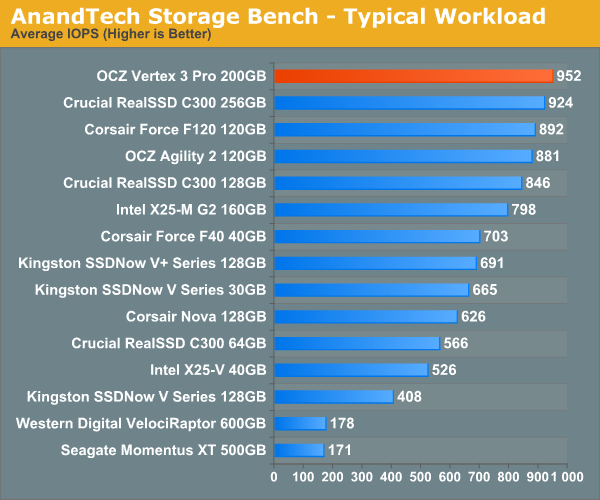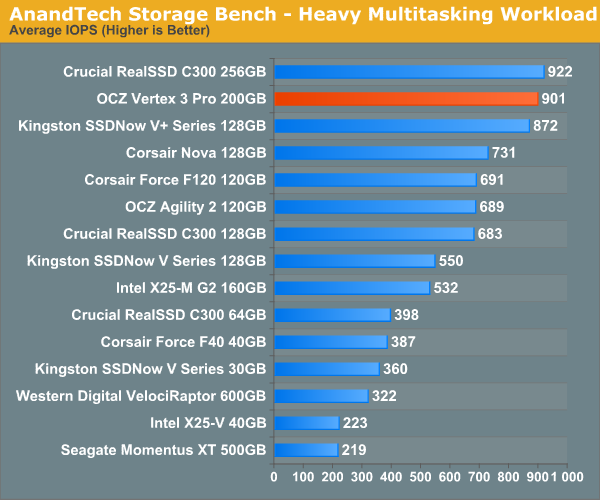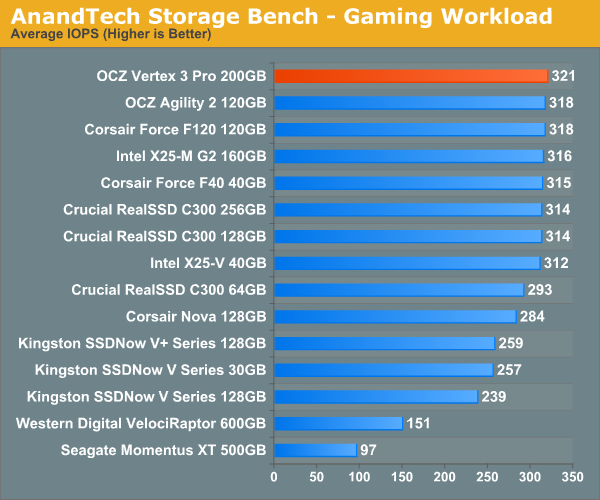OCZ Vertex 3 Pro Preview: The First SF-2500 SSD
by Anand Lal Shimpi on February 17, 2011 3:01 AM ESTAnandTech Storage Bench 2010
To keep things consistent we've also included our older Storage Bench. Note that the old storage test system doesn't have a SATA 6Gbps controller, so we only have one result for the Vertex 3 Pro (and the C300). The SF-2500 controller does respectably here, but with a 3Gbps controller we're only marginally faster than other SSDs (which is why we've moved to a new storage platform for 2011).
The first in our benchmark suite is a light/typical usage case. The Windows 7 system is loaded with Firefox, Office 2007 and Adobe Reader among other applications. With Firefox we browse web pages like Facebook, AnandTech, Digg and other sites. Outlook is also running and we use it to check emails, create and send a message with a PDF attachment. Adobe Reader is used to view some PDFs. Excel 2007 is used to create a spreadsheet, graphs and save the document. The same goes for Word 2007. We open and step through a presentation in PowerPoint 2007 received as an email attachment before saving it to the desktop. Finally we watch a bit of a Firefly episode in Windows Media Player 11.
There’s some level of multitasking going on here but it’s not unreasonable by any means. Generally the application tasks proceed linearly, with the exception of things like web browsing which may happen in between one of the other tasks.
The recording is played back on all of our drives here today. Remember that we’re isolating disk performance, all we’re doing is playing back every single disk access that happened in that ~5 minute period of usage. The light workload is composed of 37,501 reads and 20,268 writes. Over 30% of the IOs are 4KB, 11% are 16KB, 22% are 32KB and approximately 13% are 64KB in size. Less than 30% of the operations are absolutely sequential in nature. Average queue depth is 6.09 IOs.
The performance results are reported in average I/O Operations per Second (IOPS):

If there’s a light usage case there’s bound to be a heavy one. In this test we have Microsoft Security Essentials running in the background with real time virus scanning enabled. We also perform a quick scan in the middle of the test. Firefox, Outlook, Excel, Word and Powerpoint are all used the same as they were in the light test. We add Photoshop CS4 to the mix, opening a bunch of 12MP images, editing them, then saving them as highly compressed JPGs for web publishing. Windows 7’s picture viewer is used to view a bunch of pictures on the hard drive. We use 7-zip to create and extract .7z archives. Downloading is also prominently featured in our heavy test; we download large files from the Internet during portions of the benchmark, as well as use uTorrent to grab a couple of torrents. Some of the applications in use are installed during the benchmark, Windows updates are also installed. Towards the end of the test we launch World of Warcraft, play for a few minutes, then delete the folder. This test also takes into account all of the disk accesses that happen while the OS is booting.
The benchmark is 22 minutes long and it consists of 128,895 read operations and 72,411 write operations. Roughly 44% of all IOs were sequential. Approximately 30% of all accesses were 4KB in size, 12% were 16KB in size, 14% were 32KB and 20% were 64KB. Average queue depth was 3.59.

The gaming workload is made up of 75,206 read operations and only 4,592 write operations. Only 20% of the accesses are 4KB in size, nearly 40% are 64KB and 20% are 32KB. A whopping 69% of the IOs are sequential, meaning this is predominantly a sequential read benchmark. The average queue depth is 7.76 IOs.











144 Comments
View All Comments
sheh - Thursday, February 17, 2011 - link
Why's data retention down from 10 years to 1 year as the rewrite limit is approached?Does this mean after half the rewrites the retention is down to 5 years?
What happens after that year, random errors?
Is there drive logic (or standard software) to "refresh" a drive?
AnnihilatorX - Saturday, February 19, 2011 - link
Think about how Flash cell works. There is a thick Silicon Dixoide barrier separating the floating gate with the transistor. The reason they have a limited write cycle is because the Silion dioxide layer is eroded when high voltages are required to pump electrons to the floating gate.As the SO2 is damaged, it is easier for the electrons in the floating gate to leak, eventually when sufficient charge is leaked the data is loss (flipped from 1 to 0)
bam-bam - Thursday, February 17, 2011 - link
Thanks for the great preview! Can’t wait to get a couple of these new SDD’s soon.I’ll add them to an even more anxiously-awaited high-end SATA-III RAID Controller (Adaptec 6805) which is due out in March 2011. I’ll run them in RAID-0 and then see how they compare to my current set up:
Two (2) Corsair P256 SSD's attached to an Adaptec 5805 controller in RAID-0 with the most current Windows 7 64-bit drivers. I’m still getting great numbers with these drives, almost a year into heavy, daily use. The proof is in pudding:
http://img24.imageshack.us/img24/6361/2172011atto....
(1500+ MB/s read speeds ain’t too bad for SATA-II based SSD’s, right?)
With my never-ending and completely insatiable need-for-speed, I can’t wait to see what these new SATA-III drives with the new Sand-Force controller and a (good-quality) RAID card will achieve!
Quindor - Friday, February 18, 2011 - link
Eeehrmm.....Please re-evaluatue what you have written above and how to preform benchmarks.
I too own a Adaptec 5805 and it has 512MB of cache memory. So, if you run atto with a size of 256MB, this fits inside the memory cache. You should see performance of around 1600MB/sec from the memory cache, this is in no way related to what your subsystem storage can or cannot do. A single disk connected to it but just using cache will give you exactly the same values.
Please rerun your tests set to 2GB and you will get real-world results of what the storage behind the card can do.
Actually, I'm a bit surprised that your writes don't get the same values? Maybe you don't have your write cache set to write back mode? This will improve performance even more, but consider using a UPS or a battery backup cache module before doing so. Same thing goes for allowing disk cache or not. Not sure if this settings will affect your SSD's though.
Please, analyze your results if they are even possible before believing them. Each port can do around 300MB/sec, so 2x300MB/sec =/= 1500MB/sec that should have been your first clue. ;)
mscommerce - Thursday, February 17, 2011 - link
Super comprehensible and easy to digest. I think its one of your best, Anand. Well done!semo - Friday, February 18, 2011 - link
"if you don't have a good 6Gbps interface (think Intel 6-series or AMD 8-series) then you probably should wait and upgrade your motherboard first""Whenever you Sandy Bridge owners get replacement motherboards, this may be the SSD you'll want to pair with them"
So I gather AMD haven't been able to fix their SATA III performance issues. Was it ever discovered what the problem is?
HangFire - Friday, February 18, 2011 - link
The wording is confusing, but I took that to mean you're OK with Intel 6 or AMD 8.Unfortunately, we may never know, as Anand rarely reads past page 4 or 5 of the comments.
I am getting expected performance from my C300 + 890GX.
HangFire - Friday, February 18, 2011 - link
OK here's the conclusion from 3/25/2010 SSD/Sata III article:"We have to give AMD credit here. Its platform group has clearly done the right thing. By switching to PCIe 2.0 completely and enabling 6Gbps SATA today, its platforms won’t be a bottleneck for any early adopters of fast SSDs. For Intel these issues don't go away until 2011 with the 6-series chipsets (Cougar Point) which will at least enable 6Gbps SATA. "
So, I think he is associating "good 6Gbps interface) with 6&8 series, not "don't have" with 6&8.
semo - Friday, February 18, 2011 - link
Ok I think I get it thanks HangFire. I remember that there was an article on Anandtech that tested SSDs on AMD's chipsets and the results weren't as good as Intel's. I've been waiting ever since for a follow up article but AMD stuff doesn't get much attention these days.BanditWorks - Friday, February 18, 2011 - link
So if MLC NAND mortality rate ("endurance") dropped from 10,000 cycles down to 5,000 with the transition to 34nm manufacturing tech., does that mean that the SLC NAND mortality rate of 100,000 cycles went down to ~ 50,000?Sorry if this seems like a stupid question. *_*